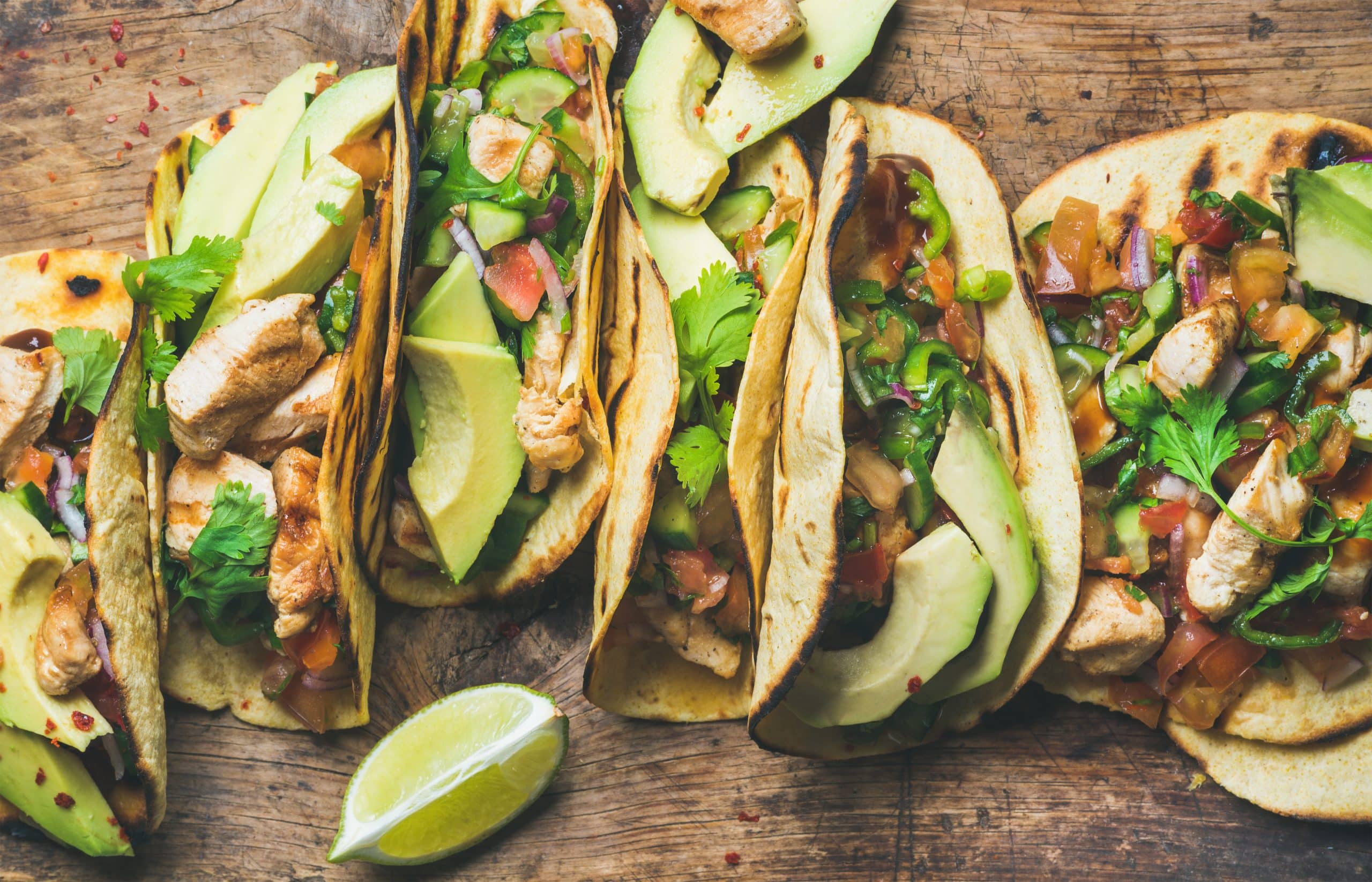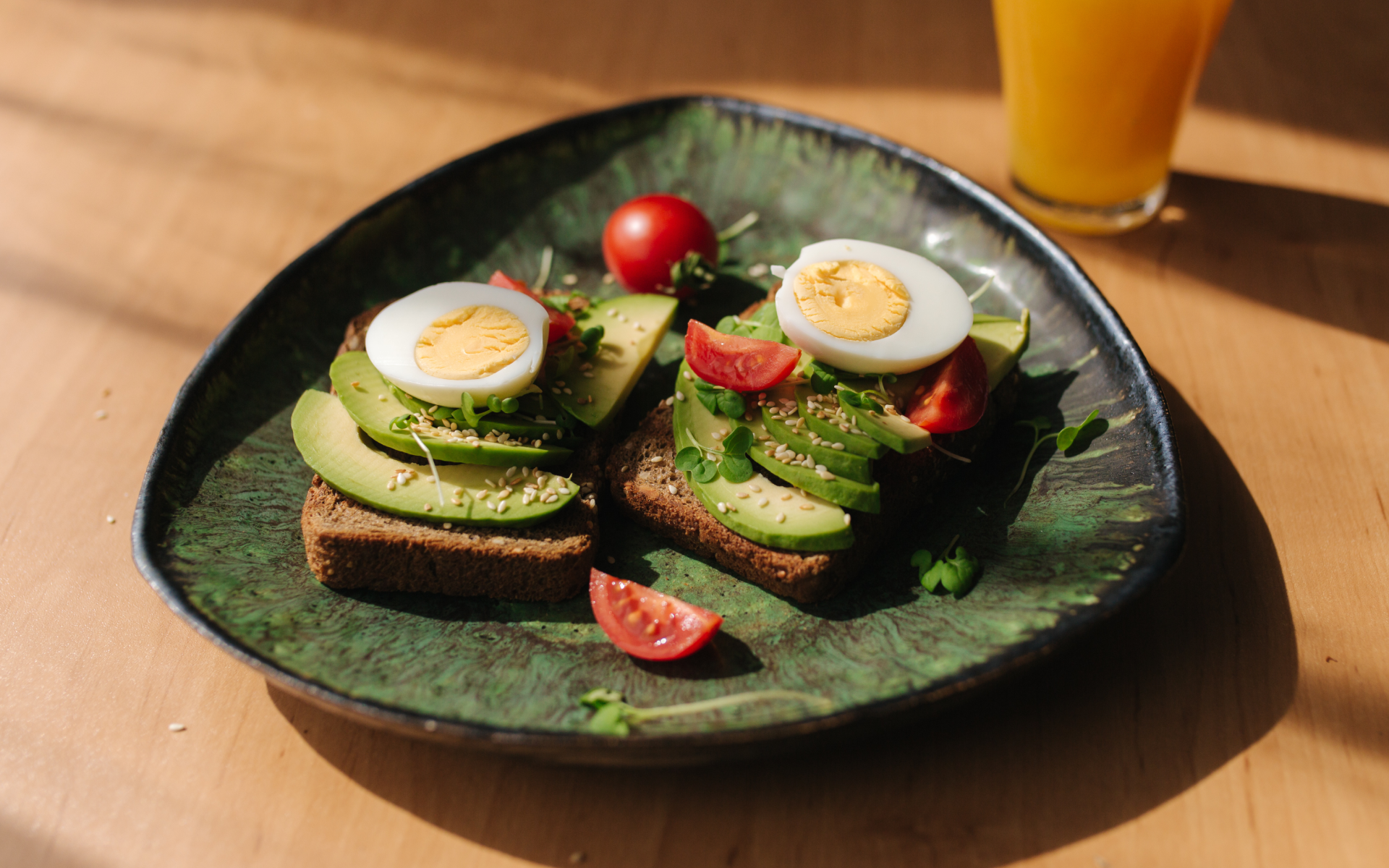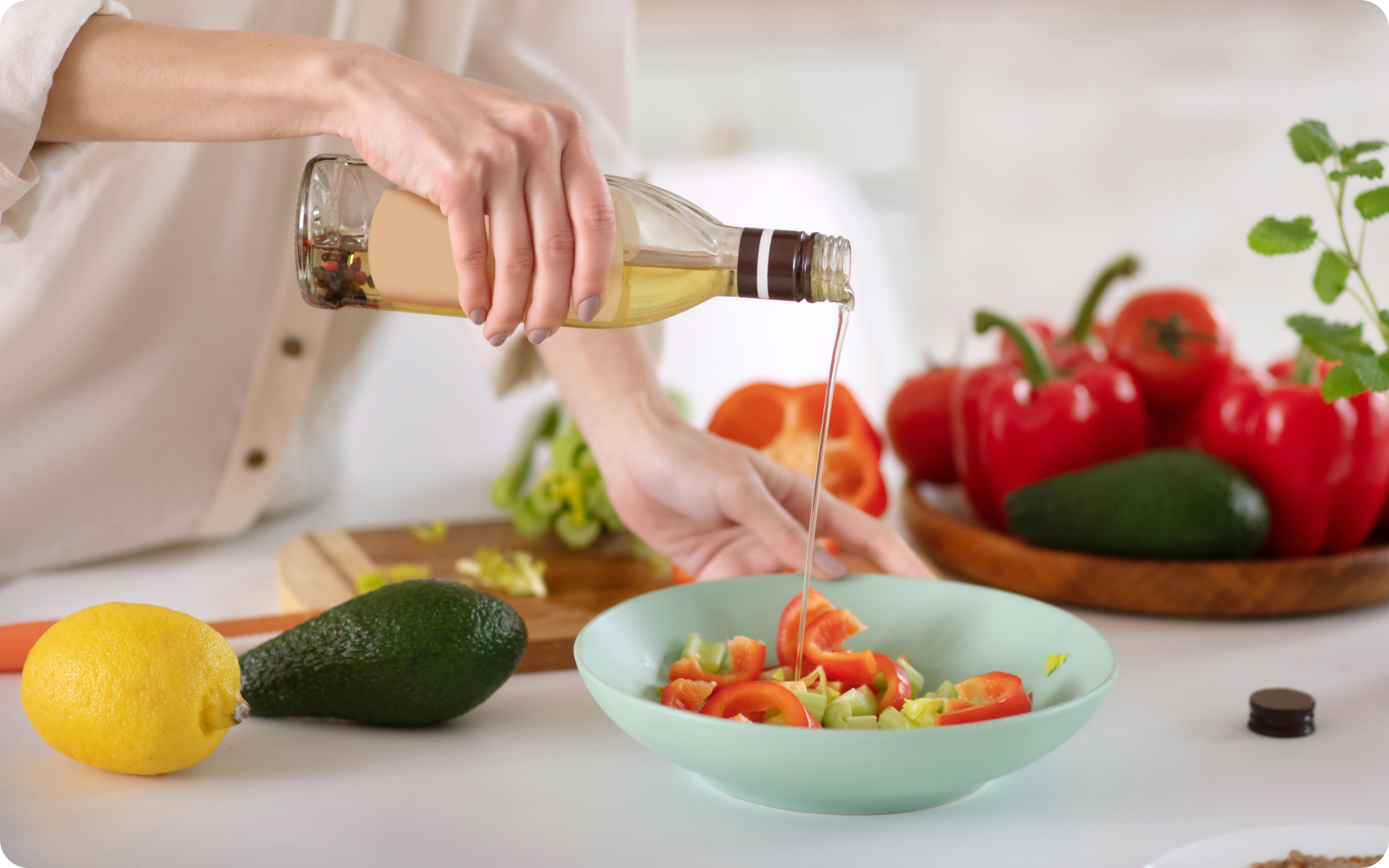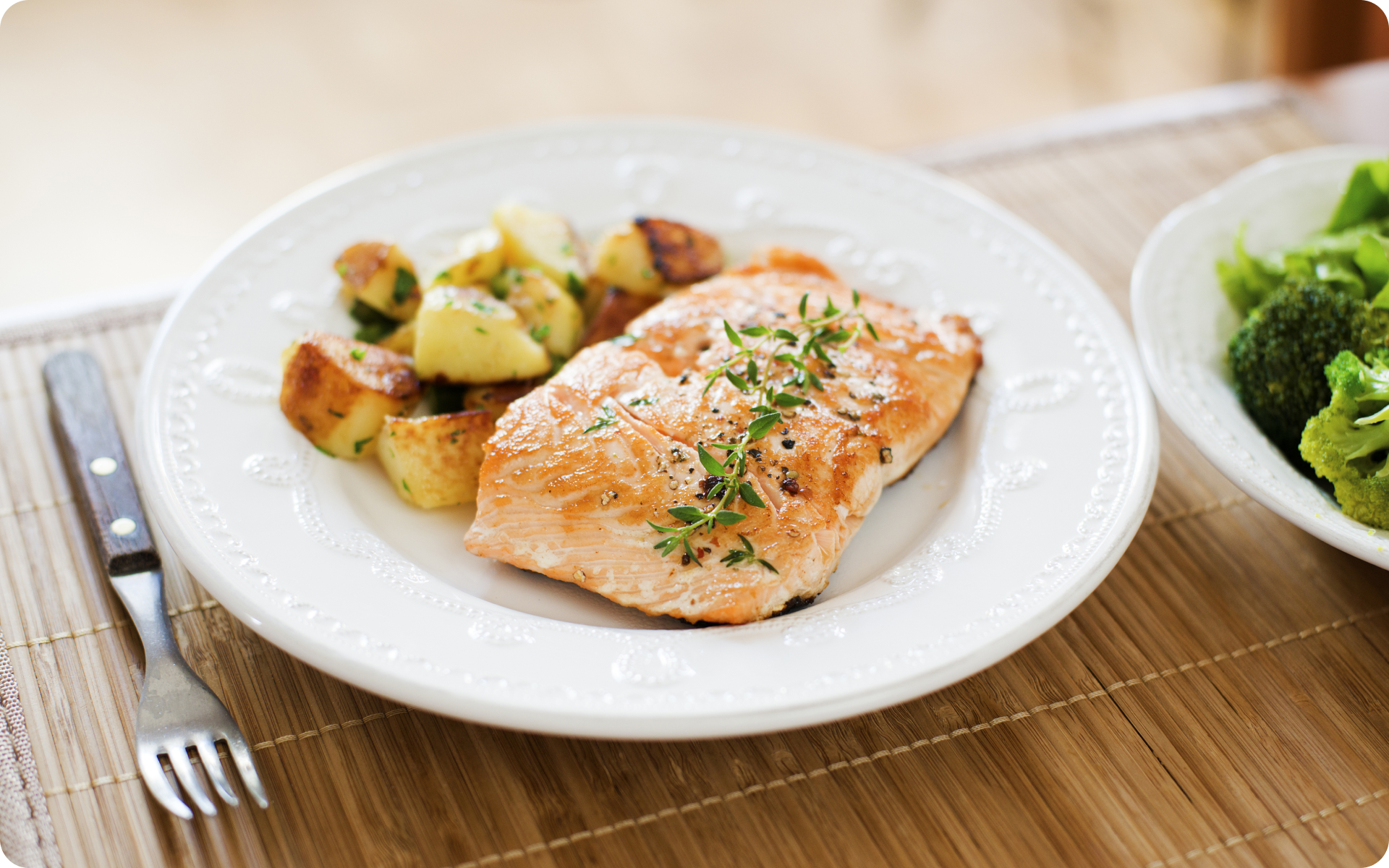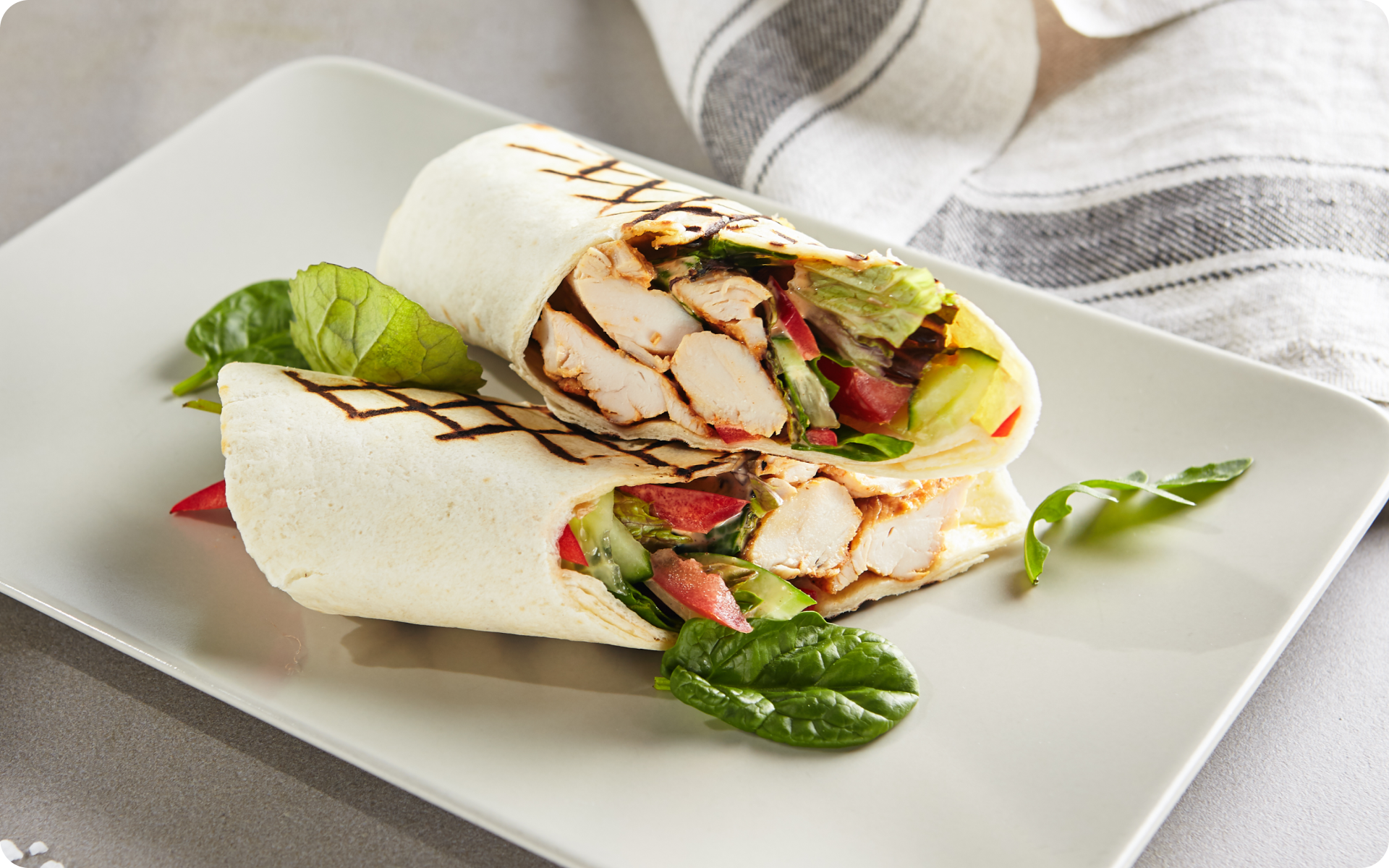Wraps are a convenient choice for quick meals, snacks, or light dinners. Filled with everything from fresh vegetables and lean proteins to savory spreads or even sweet treats, they come in handy for any eating occasion.
But what should you do when you’re closely watching your carb intake? And what if you don’t want an ultra-processed, high-carb tortilla from the local grocery store? You make a low-carb wrap at home, of course!
You’re not just limited to lettuce wraps, although they are a crisp and refreshing option. There are quite a few more imaginative and equally delicious alternatives out there. Here are 4 low-carb wraps you can make at home.
Are There Wraps Without Carbs?
Yes! Use paper-thin, sliced jicama or nori sheets instead of traditional wraps. Jicama has only 4g net carbs per 100g, while nori sheets are carb-free.
However, we understand these options may seem a little too unconventional for some people’s tastes and may not hold up as well with certain types of fillings. So here are 7 more options to try.
These are low-carb recipes, which means they aren’t entirely carb-free but have significantly lower carbs than regular flour-based wraps.
3-Ingredient Keto Tortillas (3)
With just almond flour, psyllium husk, and olive oil, you can whip up some keto-friendly tortillas that’ll make you forget about the high-carb versions. Almond flour is low in carbs but high in fiber and healthy fats, which makes it a keto favorite. Psyllium husk is a prebiotic fiber that’s beneficial for digestive health, while olive oil brings in those heart-healthy fats. It’s a simple, nutritious trio that packs a punch.
Ingredients
- 2 cups almond flour
- 6 tablespoons psyllium husks (not psyllium husk powder, as this will make your tortillas crumbly)
- 1 teaspoon salt
- 1 tablespoon olive oil
- 1 cup warm water (not boiling)
Instructions
- In a mixing bowl, whisk together the almond flour, psyllium husk, and salt.
- Add olive oil and warm water, then stir until well combined.
- Allow the mixture to sit for approximately 5 minutes to thicken up.
- Divide dough into equal portions and roll out each portion between two sheets of parchment paper.
- Heat a non-stick pan or griddle over medium heat and cook each tortilla for approximately 1-2 minutes on each side.
- Serve warm or store in an airtight container for later use.
Nutrition
Serving: 1 tortilla (recipe makes 8) | Calories: 195 kcal | Carbohydrates: 11g | Protein: 6g | Fat: 15g | Sodium: 291mg | Fiber: 9g | Calcium: 81mg | Iron: 1mg
BetterMe is your fast-track ticket to a long-lasting weight loss! Tailor your fitness journey and maximize your results with just a couple of swipes!
Almond Flour Tortillas (8)
Imagine enjoying tortillas without the worry of breaking your keto stride. Almond flour combined with xanthan gum makes this possible. Almond flour is a star in keto cooking due to its low-carb and high-fiber profile. Xanthan gum steps in to provide that elasticity and flexibility we all love in tortillas, but without any carbs.
Ingredients
- 2 cups pre-shredded/grated mozzarella low-moisture
- 1 cup almond meal/flour
- 1 tsp xanthan gum
Instructions
- Start by preheating a non-stick pan over medium heat, making sure it’s hot before you begin cooking the tortillas.
- In a microwave-safe bowl, add the pre-shredded mozzarella. Microwave on high for 1 minute, or until fully melted. Stirring halfway through to ensure even melting.
- Quickly add the almond meal/flour and xanthan gum to the melted mozzarella. Mix vigorously until the ingredients form a dough. The warmth of the cheese will help bind everything together.
- Once the dough has formed, divide it into equal portions. A good size is approximately the size of a golf ball, but you can adjust this based on how large or small you want your tortillas to be.
- Place one portion of the dough between two pieces of parchment paper. Use a rolling pin to roll out the dough into a thin, round shape. Aim for approximately 1/8 inch thickness for the best flexibility.
- Carefully peel off the top layer of parchment paper. If the dough sticks, chill it for a few minutes in the refrigerator to firm it up slightly to make it easier to work with.
- Transfer the tortilla on the bottom piece of parchment to the preheated pan. Cook for approximately 1-2 minutes on the first side. You’ll know it’s ready to flip when the edges start peeling away from the parchment.
- Carefully flip the tortilla (you can use the parchment to help if needed) and cook for another 1 minute on the other side, or until it achieves a slightly golden color.
- Remove from the pan and cool on a wire rack to maintain flexibility. Repeat with the remaining dough.
- Serve warm with your favorite fillings, or allow them to cool and store in an airtight container for up to a few days. Reheat them in a pan over low heat for best results.
Nutrition
Serving: 1 tortilla (recipe makes 8) | Calories: 164.3kcal | Carbohydrates: 3.9g | Protein: 9.2g | Fat: 13.2g | Sodium: 186.4mg | Potassium: 21.3mg | Fiber: 1.8g | Sugar: 0.8g | Vitamin A: 189.3IU | Calcium: 170.8mg | Iron: 0.7mg
Flaxseed Wraps (4)
If there’s a superfood that fits seamlessly into a keto diet, it’s flaxseed. These wraps are incredibly easy to prepare and are also packed with omega-3 fatty acids, fiber, and protein. Flaxseeds have an amazing ability to keep you feeling full longer, which can help manage appetite.
Ingredients
- 1 cup (108 g) flaxseed meal (If you’re using store-bought flaxseed meal, make sure it’s finely ground)
- 2/3 cup (160 ml) hot water
- 1/2 tsp. (2.9 g) salt
Instructions
- Start by preheating a non-stick pan over medium heat. This will ensure your wraps cook evenly and acquire a nice texture.
- In a medium-sized bowl, combine the flaxseed meal and salt. Mix well to distribute the salt evenly throughout the flaxseed meal.
- Pour the hot water into the bowl with the flaxseed meal and salt. Use a spoon to stir the mixture vigorously until it forms a cohesive dough. The hot water will help the flaxseed meal become more pliable and stick together better.
- Once your dough has formed, divide it into equal-sized portions. The size of these portions will depend on how large you want your wraps to be. A good starting point is dividing the dough into balls roughly the size of a golf ball for standard-sized wraps.
- Place a portion of the dough between two sheets of parchment paper. Using a rolling pin, roll out the dough to your desired thickness, aiming for approximately 1/16 to 1/8 inch thick. The thinner the wrap, the more flexible and wrap-like it will be.
- Carefully peel away the top layer of parchment paper. If the dough sticks or is too fragile, you may need to chill it in the refrigerator for a few minutes to firm up.
- With the bottom parchment paper still attached, transfer the rolled-out dough to the preheated pan. Cook for 1-2 minutes, or until the edges start to lift slightly and the bottom has developed a light golden color.
- Flip the wrap carefully, using the parchment paper if needed for support, and cook for an additional minute on the other side. Look for a slightly golden color as an indicator of doneness.
- Remove the wrap from the pan and cool on a wire rack. Cooling on a rack helps prevent the wraps from becoming soggy.
- Repeat the process with the remaining dough portions. Remember, the wraps are best served warm but can be stored in an airtight container and gently reheated in a pan over low heat when you’re ready to enjoy them.
Nutrition
Serving: 1 of 5 | Calories: 171 kcal | Carbohydrates: 9g | Protein: 6g | Fat: 13g | Fiber: 9g | Sugar: 0g
Read more: 6 Low Carb Thanksgiving Sides That Even Carb-Lovers Will Enjoy
Coconut Flour Tortillas (7)
Coconut flour is a fantastic choice for anyone who is looking to cut down on carbs while still indulging in delicious meals. It’s low in carbs and high in fiber. These tortillas are light, flavorful, and perfect for wrapping up your favorite keto fillings.
Ingredients
- ⅓ cup coconut flour
- 1 ½ cups egg white liquid
- ¼ tsp baking powder
- ½ cup water to thin
- coconut oil spray
Instructions
- Start by combining the coconut flour and baking powder in a large mixing bowl. Whisk these dry ingredients together until they’re well mixed and free of clumps. This step is essential for achieving a smooth and even texture in your tortillas.
- Next, slowly incorporate the egg whites into the mixture. Use a fork or a whisk to blend them thoroughly with the dry ingredients. This will start to form your tortilla batter. It’s important to ensure the egg whites are fully integrated to avoid any inconsistency in the batter.
- Gradually add water to the batter while stirring continuously. The goal is to reach a consistency that is thin enough to spread on a pan but thick enough to hold together as a tortilla. Adjust the amount of water as needed, but the listed ½ cup should be a good starting point.
- Heat a non-stick skillet over medium heat and lightly grease it with coconut oil spray to prevent sticking. The oil also contributes to achieving a slightly crispy edge, which enhances the overall texture of the tortillas.
- Pour a portion of the batter into the center of the skillet, using a ladle or a measuring cup for consistency in size. Immediately tilt and swirl the skillet to spread the batter into a thin, even layer across the surface.
- Cook the tortilla for approximately 1-2 minutes, or until the edges start to lift from the pan and the bottom has turned light golden brown. Carefully flip the tortilla using a spatula and cook for an additional minute on the other side.
- Remove the cooked tortilla and place it on a plate or a wire rack to cool. This will prevent it from steaming and becoming soggy. Continue with the remaining batter, greasing the skillet as needed, until all tortillas are cooked.
- Serve the coconut flour tortillas warm with your choice of keto-friendly fillings or store them in an airtight container in the refrigerator. To reheat, simply place them in a pan over low heat for a few minutes until they’re warm and pliable.
Nutrition
Serving: 1 (recipe makes 12) | Calories: 29 kcal | Carbohydrates: 2g | Protein: 3g | Sodium: 58mg | Potassium: 60mg | Fiber: 1g | Calcium: 7mg | Iron: 0.1mg
If you’ve mustered up the courage to crush your weight loss goal, let Betterme take the sting out of this demanding process. Our app will help you restructure your habits, remold your life and crank up your fitness results!
Are Low-Carb Wraps Better Than Bread?
Whether low-carb wraps are better than bread depends on individual dietary needs, health goals, and the specific types of wraps and bread in question. However, for those who are managing their carbohydrate intake—either for weight management, blood sugar control, or dietary preferences—low-carb wraps can offer several advantages over traditional bread. Here’s how:
1. Lower in Carbohydrates
The most apparent advantage of low-carb wraps over traditional bread is their reduced carbohydrate content. This is particularly beneficial for those who are following ketogenic diets, those with diabetes who are aiming to manage blood sugar levels, or anyone who is looking to lower their carbohydrate intake (1).
By substituting bread with low-carb wraps, you can enjoy similar meals while significantly reducing carbohydrate consumption, which can help with weight management and blood sugar stability.
2. Higher in Fiber
Many low-carb wraps are crafted to be high in dietary fiber, which is beneficial for digestive health and can help you feel fuller for longer. High-fiber diets are associated with a lower risk of developing heart disease, stroke, hypertension, diabetes, obesity, and certain gastrointestinal diseases. They can also improve cholesterol levels, lower blood pressure, and enhance weight management (11). Fiber in low-carb wraps can contribute to overall health and well-being.
3. Greater Nutritional Variety
Low-carb wraps often incorporate a variety of alternative flours and seeds, such as almond flour, coconut flour, and flaxseeds, which varies their nutritional profiles (6). These ingredients may offer different nutritional benefits, including higher levels of certain vitamins, minerals, and essential fats than traditional wheat flour-based bread.
4. Better for Weight Management
Due to their lower carbohydrate and often higher fiber content, low-carb wraps can be an effective tool for weight management. High-fiber foods keep you feeling fuller for longer while also helping prevent overeating (3). Lower carbohydrate intake can lead to reduced calorie consumption and facilitate weight loss or maintenance (1). Reducing carbohydrates is not the only way to lose weight, but it isn’t for everyone.
5. Gluten-Free Options
For those with celiac disease or gluten sensitivity or anyone who is choosing to avoid gluten, low-carb wraps are often made without wheat or any gluten-containing ingredients, which makes them a safe and appealing alternative to bread that typically contains gluten.
6. Versatile and Convenient
Low-carb wraps are incredibly versatile and can be used in a variety of meals, from breakfast burritos to lunch wraps, and even as a base for low-carb pizzas. Their flexibility and the ease with which they can be incorporated into meals make them a convenient option for meal planning and preparation.
7. May Improve Gut Health
The alternative ingredients that are used in many low-carb wraps, such as coconut flour and almond flour, may offer prebiotic benefits, feeding the good bacteria in the gut and promoting a healthy gut microbiome (2) (12). A healthy gut is essential for overall health as it influences everything from digestion to immune function.
Read more: Your Guide to High Fat Keto Foods: The Best Choices for a Low Carb Diet
FAQs
Are low-carb wraps really low-carb?
Low-carb wraps, by definition, have a lower carbohydrate content than traditional flour-based tortillas or bread. However, the exact amount of carbs will vary depending on the specific recipe and ingredients that are used. It’s important to check labels or recipes for nutritional information and compare it with regular wraps or bread to determine their relative carb content.
Is rice high in carbs?
Yes, rice is a high-carb food. A cup of white rice contains approximately 53 grams of carbohydrates (10), while brown rice has approximately 51 grams of carbs per cup (9).
Brown rice is often considered to be a slightly healthier option due to its higher fiber content, but both types of rice are still high in carbs than other low-carb alternatives such as cauliflower rice or shirataki noodles.
The same applies to other variants of rice, such as basmati or jasmine rice. They all have relatively high carb contents and may not be suitable in large portions for those who are trying to manage their carbohydrate intake.
What is dirty keto?
Dirty keto is a version of the popular low-carb, high-fat ketogenic diet that focuses on consuming mostly fast food or ultra-processed foods that are high in unhealthy fats and low in micronutrients. While it may result in initial weight loss, this approach to keto is not sustainable in the long term and can have negative effects on overall health.
Are low-carb wraps allowed on keto?
Yes, low-carb wraps can be an excellent option for those who are following a ketogenic diet. They offer a convenient and versatile way to enjoy your favorite meals while staying within your daily carbohydrate limit. However, as with any food on keto, it’s important to monitor your overall carb intake and stay within your individual macro goals.
Are keto buns really low-carb?
Like any other low-carb product, keto buns will vary in their actual carb content depending on the brand and ingredients that are used. Some keto buns may have a relatively high carbohydrate content due to added starches or fillers. It’s important to check labels for nutritional information and choose products with lower total carbs and higher fiber content.
Are zero-carb tortillas good for keto?
The term “zero-carb” can be misleading, as most foods have some trace amounts of carbohydrates. However, certain tortillas marketed as zero carbs are typically very low in net carbs (total carbs minus fiber), which makes them suitable for a keto diet. Again, it’s essential to check labels and consider individual carb goals when incorporating any food into your keto meal plan.
Does fiber actually cancel carbs?
Fiber doesn’t cancel out carbs, but it can play a significant role in balancing blood sugar levels and managing carb intake. Fiber is a type of carbohydrate that the body cannot digest, which means it doesn’t contribute to an increase in blood sugar levels (11).
Therefore, when calculating net carbs (total carbs minus fiber) for a low-carb meal, the fiber content is often deducted to determine the overall carb impact on blood sugar.
Low-carb wraps with added fiber can be a beneficial option for those who are looking to manage their carb intake while maintaining healthy intakes of dietary fiber.
The Bottom Line
Low-carb wraps offer a convenient and versatile alternative to traditional flour-based bread. They are an appealing option for those who are looking to reduce their carbohydrate intake or follow specific dietary protocols such as keto.
They provide various potential health benefits, such as improved blood sugar control, weight management, and gut health. However, it’s important to consider your individual nutritional needs and goals when incorporating low-carb wraps into a meal plan and always read ingredient labels to ensure the product aligns with your dietary restrictions or preferences.
DISCLAIMER:
This article is intended for general informational purposes only and does not serve to address individual circumstances. It is not a substitute for professional advice or help and should not be relied on for making any kind of decision-making. Any action taken as a direct or indirect result of the information in this article is entirely at your own risk and is your sole responsibility.
BetterMe, its content staff, and its medical advisors accept no responsibility for inaccuracies, errors, misstatements, inconsistencies, or omissions and specifically disclaim any liability, loss or risk, personal, professional or otherwise, which may be incurred as a consequence, directly or indirectly, of the use and/or application of any content.
You should always seek the advice of your physician or other qualified health provider with any questions you may have regarding a medical condition or your specific situation. Never disregard professional medical advice or delay seeking it because of BetterMe content. If you suspect or think you may have a medical emergency, call your doctor.
SOURCES:
- Benefits of Low Carbohydrate Diets: a Settled Question or Still Controversial? (2022,nih.gov)
- Coconut Flour: Nutrition, Benefits, and More (2022,medicinenet.com)
- Effect of Fibre Supplementation on Body Weight and Composition, Frequency of Eating and Dietary Choice in Overweight Individuals (2017,nih.gov)
- FLAXSEED WRAPS (2018,nutritionrefined.com)
- Keto Tortillas (2021,thebigmansworld.com)
- Low carbohydrate high fat flour: its rheology, bread making, physico-sensory and staling characteristics (20022,nih.gov)
- Low Carb Tortillas (2019,thekelliekitchen.com)
- Libby’s Keto Tortillas: 3-ingredients (Egg Free) (n,d,thinlicious.com)
- Rice, brown, long-grain, cooked (2019,usda.gov)
- Rice, white, medium-grain, enriched, cooked (2019,usda.gov)
- The Health Benefits of Dietary Fiber (2020,nih.gov)
- The impact of almonds and almond processing on gastrointestinal physiology, luminal microbiology, and gastrointestinal symptoms: a randomized controlled trial and mastication study (2022,nih.gov)
